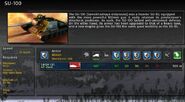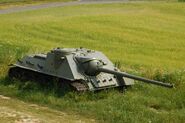The SU-100 is an advanced tank destroyer, these monstrosities can destroy many tanks, even the largest ones, in a matter of a few shots. Many tanks won't even last its first shot; if they do, then they won't last much longer. Outfitted with a 100mm gun, or a Large AP cannon, the SU-100 comes at a $25 cost. Perfect to build multiple amounts of them to resist against rushes, large attacks, bum rushes, etc. The only downsides (like usual AT/TD) are; that it must stop to fire, and it has no air/infantry defenses.
History[]
It was developed in 1944 as an improvement to the SU-85, built on the same chassis as the T-34-85 tank. It was designed and built at the UZTM (Уральский Завод Тяжелого Машиностроения - Ural Heavy Machinery Factory, also called Uralmash) in Yekaterinburg. The SU-100 quickly proved itself to be among the best self-propelled anti-tank guns of World War II, able to penetrate 125mm of vertical armor from a range of 2,000m and the sloped 85mm front armor of the German Panther from 1,500m. This was quite capable of defeating the frontal arc of any German tank in service with the exception of the King Tiger, for which Soviet soldiers gave it the obscene nickname "Pizdets vsemu" ("F*** up everything")
The development was conducted under supervision of L. I. Gorlitskiy, chief designer of all medium Soviet self-propelled guns. The work started in February 1944 and first prototype of SU-100 was built in March. After intensive testing with different models of 100mm gun Soviet engineers approved the D-10S gun for mass production. This gun was developed in Constructors Bureau of Artillery Factory No. 9 under guidance of F. F. Petrov. After the Second World War it was installed on T-54 and T-55 tanks and its derivatives were in service forty years after initial development. The hull of SU-100 had major improvements over the SU-85; thickness of front armor plate was increased from 45 to 75mm (1.8 to 3.0in), and the commander's workplace was made in small sponson on the right side of the hull; combined with the commander's cupola this greatly improved the commander's effectiveness. For better ventilation two ventilator units were installed, instead of only one as in the SU-85. Mass production began in September 1944.
The SU-100 saw extensive service during the last year of the war. It was used en masse in Hungary in March 1945, when Soviet forces defeated the German Operation Frühlingserwachen offensive at Lake Balaton. By July 1945, 2,335 SU-100s had been built.
The vehicle remained in service with the Red Army well after the war; production continued in the Soviet Union until 1947 and into the 1950s in Czechoslovakia. It was withdrawn from Soviet service in 1957 but many vehicles were transferred to reserve stocks. Some exist to this day in the Russian Army holding facilities.
Strategy[]
This section is a stub, so be patient and expand it.
Pros & Cons[]
Weapons[]
| Weapon | ||||||||||
|---|---|---|---|---|---|---|---|---|---|---|
Large cal. AP shell |
483 | 121 | 60 | 30 | 24 | 15 | 500m |
Gallery[]
Notes[]
- The SU-100 has an extremely long range when paired up with recon; use this to your advantage.
- Although hampered by slow speeds, the range of its gun guarantees you will not have to get too close to engage the enemy.
- With 60mm of armor, this beast is nearly indestructible. But when by itself and facing several enemy medium or higher tanks, it can be brought down quickly.
- It is best used in packs and accompanied by many tanks - such as the T-34 or the IS-2.
- As with nearly every other armored unit, its main enemy is the fighter-bomber. Using 3+ ZSU-37 anti-aircraft tanks will drive groups of aircraft away.
- This destroyer is one of the few with good armor and a extremely powerful shot.
See also[]
| ||||||||||||||||||||||||||


